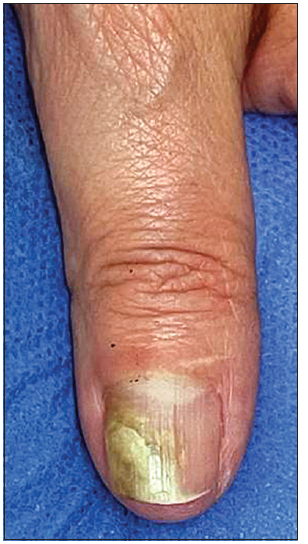Full HTML
Chloronychia: Fox–Goldman syndrome
Julio Salas-Alanís1, María G. Moreno-Treviño2, Gerardo Rivera-Silva2
Author Affiliation
1Dermatologist, Department of Dermatology, Dermatological Institute of Jalisco, Zapopan, JAL,
2Vice-rector of Health Sciences, Department of Academic, School of Medicine, University of Monterrey, Monterrey, NL, Mexico
Abstract
A 48-year-old woman came to our clinic with a symptomatic greenish discoloration of the nail plate of the left thumb that had occurred spontaneously 6 months previously. The patient has a history of diabetes mellitus and arterial hypertension. Her current occupation is as a dishwasher in a restaurant.
DOI: 10.32677/yjm.v3i1.4317
Pages: 63-63
View: 3
Download: 4
DOI URL: https://doi.org/10.32677/yjm.v3i1.4317
Publish Date: 11-05-2024
Full Text
A 48-year-old woman came to our clinic with a symptomatic greenish discoloration of the nail plate of the left thumb that had occurred spontaneously 6 months previously. The patient has a history of diabetes mellitus and arterial hypertension. Her current occupation is as a dishwasher in a restaurant. She informed us that the discoloration had appeared 2 months after starting her job (the association between humidity and Pseudomonas is known). Physical examination showed distal onycholysis and greenish discoloration of the nail plate (Fig. 1).

Figure 1: Persistent greenish pigmentation of the nail plate (chloronychia)
Bacteriological culture of nail scrapings was positive for Pseudomonas aeruginosa. Fungal coinfection was excepted by potassium hydroxide preparation and culture. The clinical diagnosis was green nail syndrome caused by P. aeruginosa (chloronychia) or Fox–Goldman syndrome.
The chloronychia is a work-related illness of homemakers, hospital employees, and others often with wet fingers [1]. This malady is caused by P. aeruginosa and is characterized by onycholysis and greenish blue (chloronychia) or white (leukonychia) or red (retronychia) discoloration of the nail [1,2]. Our patient responded satisfactorily to oral ciprofloxacin. After 3 weeks, the nail plate returned to its normal coloration [3].
However, we should consider:
• Worker education is fundamental in the prevention of chloronychia
• Chloronychia is an occupational disease, caused by P. aeruginosa
• Chloronychia could be relayed by health-care workers.
CONSENT FOR PUBLICATION
Written informed consent was obtained from patient for the publication of this case report and all associated images.
AUTHORS’ CONTRIBUTIONS
All authors contributed to the completion of this work. The final manuscript was read and approved by all authors
References
1. Schwartz RA, Reynoso-Vasquez N, Kapila R. Chloronychia: The goldman-fox syndrome-implications for patients and healthcare workers. Indian J Dermatol 2020;65:1-4.
2. Chiriac AE, Chiriac A, Wollina U. Chloronychia in healthcare workers in COVID-19 times. Skin Appendage Disord 2021;7:80-1.
3. Chiriac A, Brzezinski P, Foia L, et al. Chloronychia: Green nail syndrome caused by Pseudomonas aeruginosa in elderly persons. Clin Interv Aging 2015;10:265-7.
